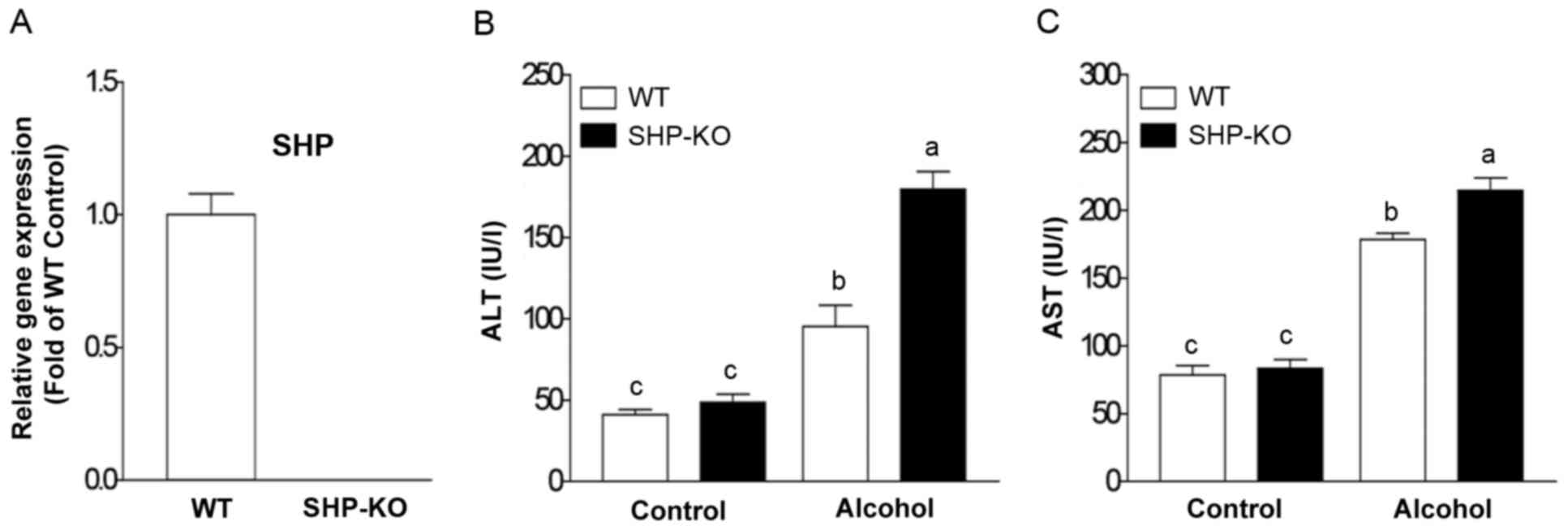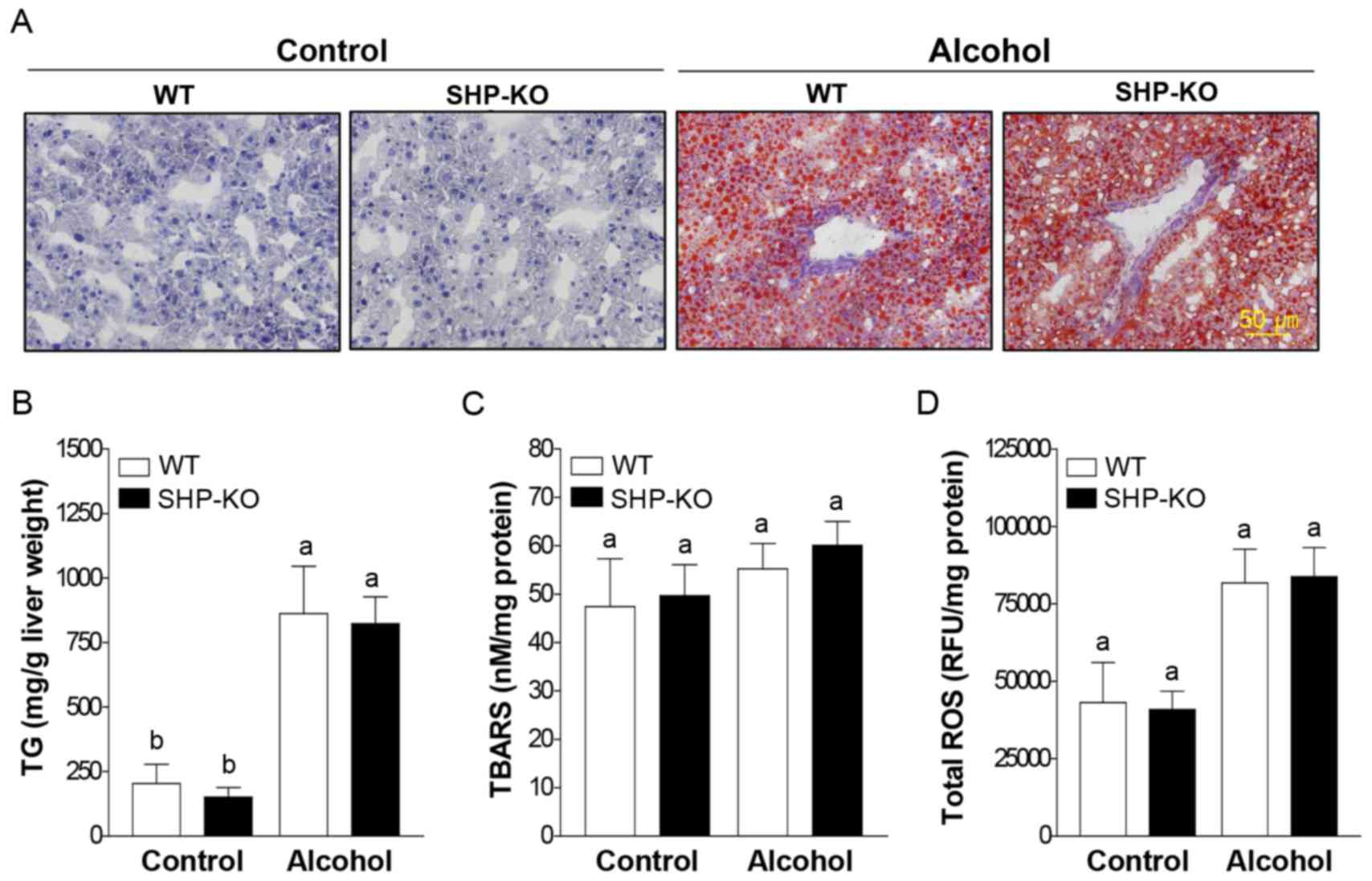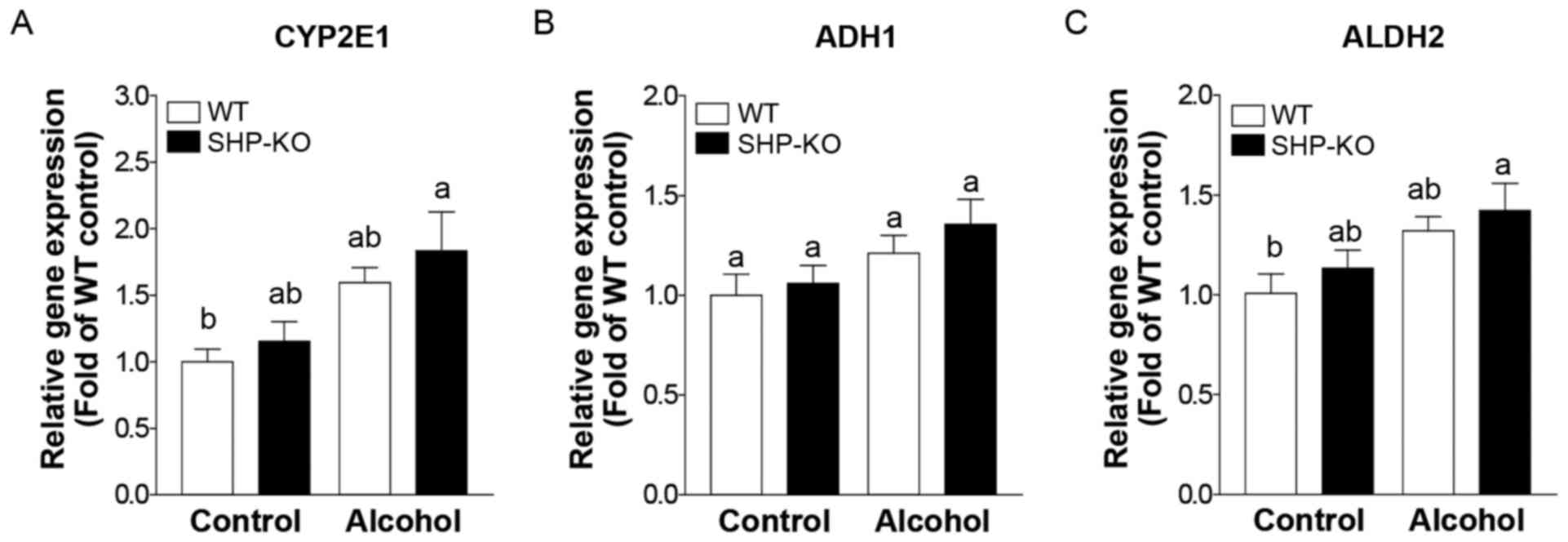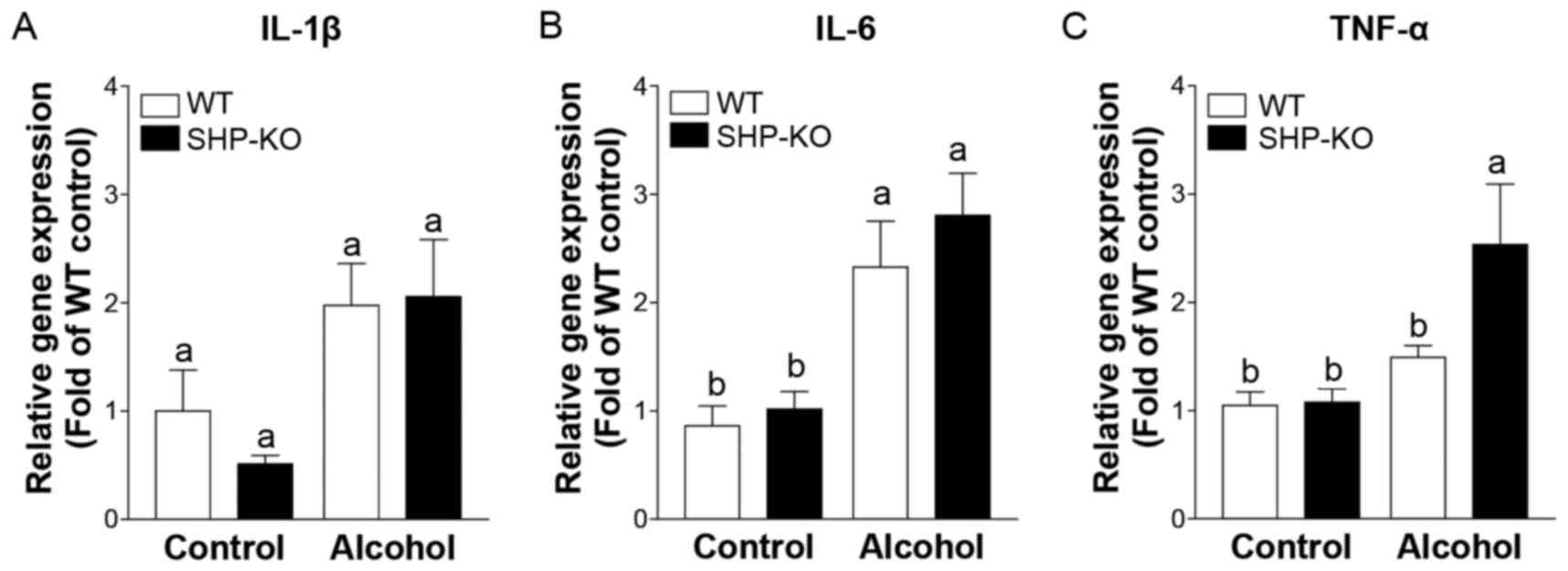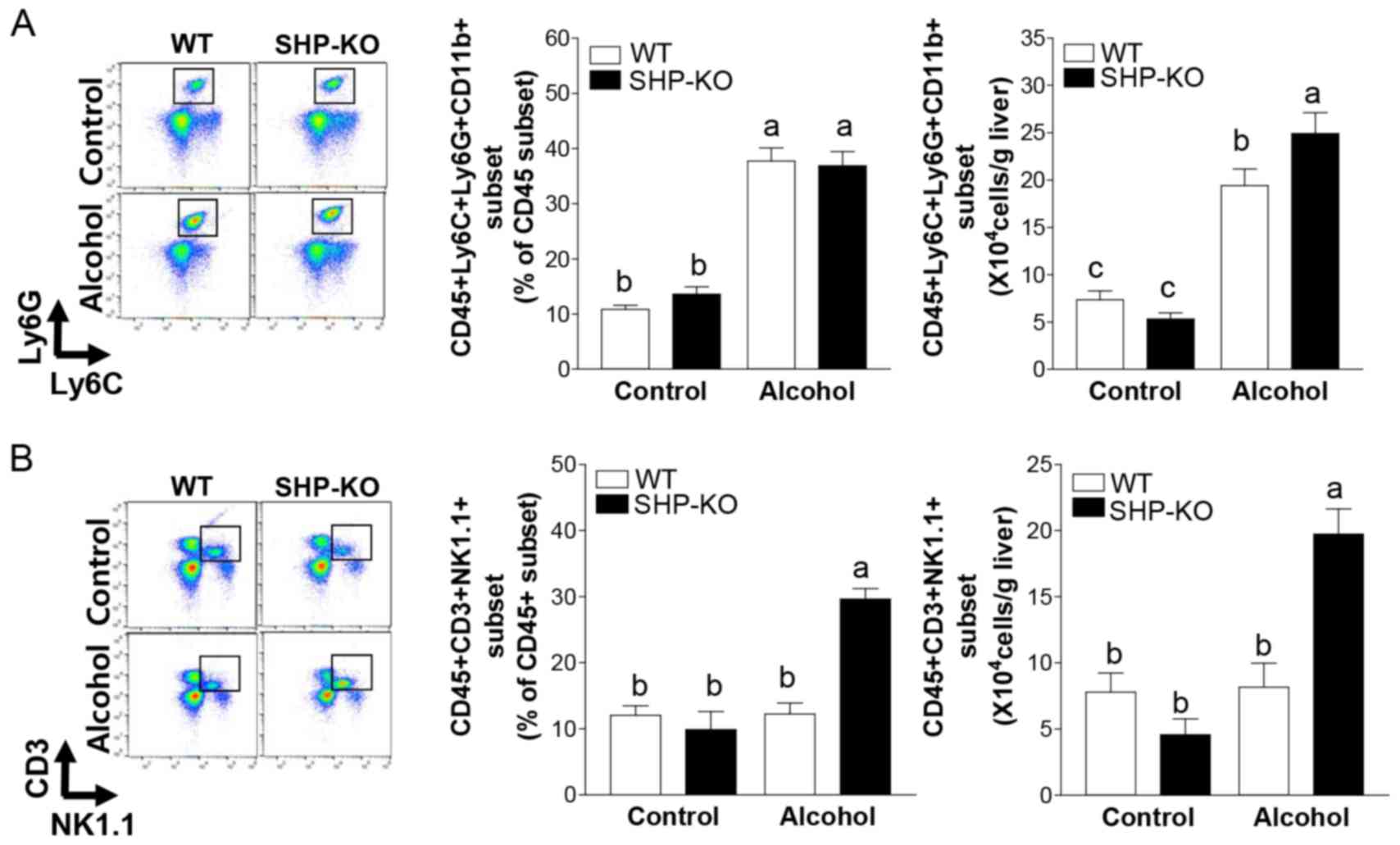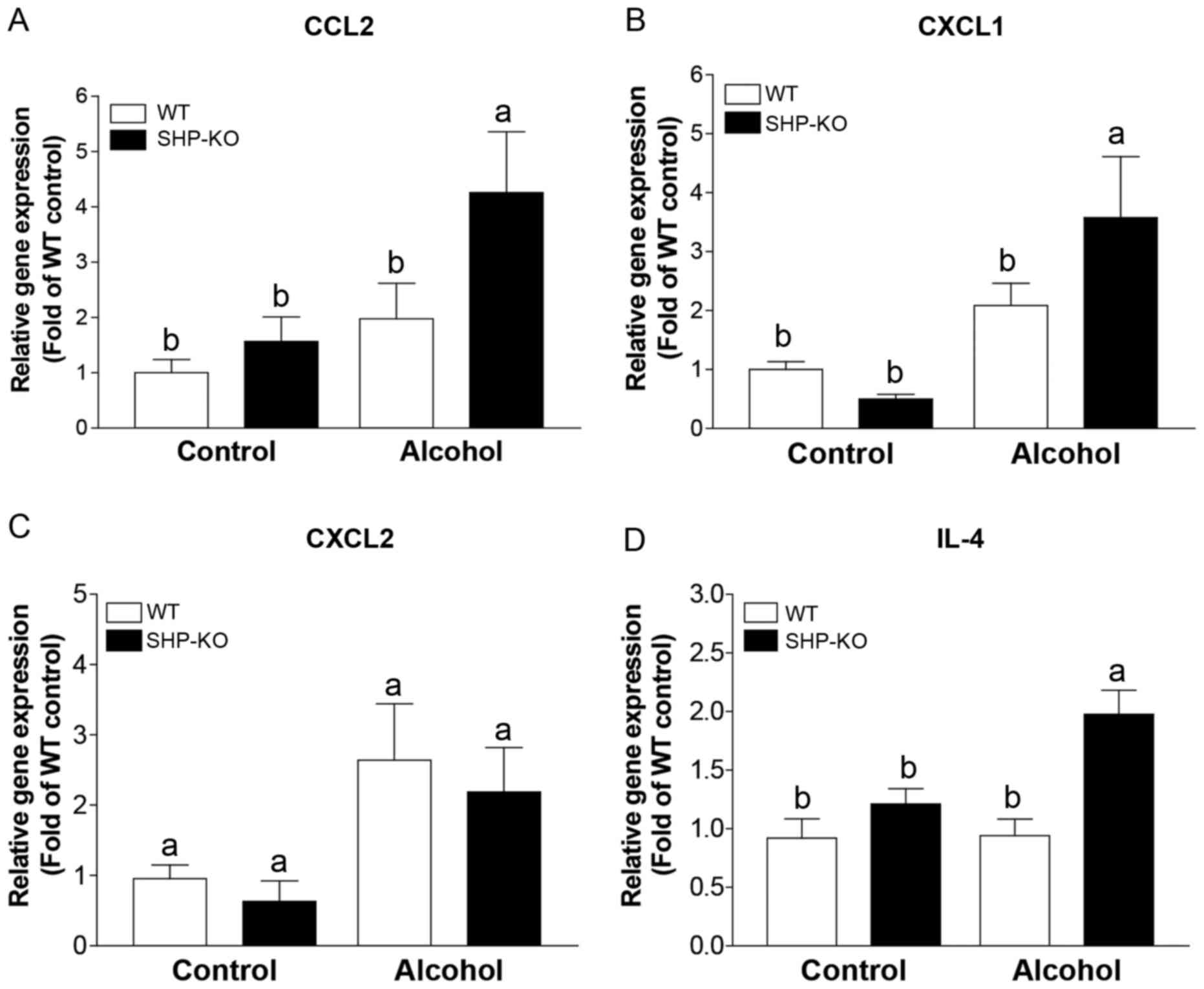Small heterodimer partner deficiency exacerbates binge drinking‑induced liver injury via modulation of natural killer T cell and neutrophil infiltration
- Authors:
- Published online on: January 26, 2018 https://doi.org/10.3892/mmr.2018.8505
- Pages: 4989-4998
-
Copyright: © Go et al. This is an open access article distributed under the terms of Creative Commons Attribution License.
Abstract
Introduction
Excessive alcohol consumption is an important health issue globally, with ~3.3 million mortalities occurring annually worldwide as a result of alcohol consumption (1). The National Institute on Alcohol Abuse and Alcoholism defines binge drinking as a pattern of drinking that elevates blood alcohol concentration levels to ≥0.08 g/dl (2). Harmful effects of binge drinking, including enhanced coronary calcification, plaque formation and circulatory dysfunction, have previously been reported (3). Furthermore, binge drinking has been revealed to increase mortality in patients with acute myocardial infarction, or cancers of the oropharynx and esophagus. In addition, binge drinking is reported to substantially aggravate liver injury in individuals that chronically abuse alcohol (4). Therefore, a comprehensive understanding of the underlying mechanisms of binge drinking-induced injury and its association with patient health is of great importance.
The liver has an important role in the regulation of host immune responses to various pathogens and toxins, and contains various types of immune cells (5,6). Natural killer T (NKT) cells account for 20–30% of liver lymphocytes in mice and are involved in the pathogenesis of various immune-mediated liver diseases (7–10). Furthermore, NKT cells are reported to contribute to liver damage following chronic alcohol consumption via the promotion of hepatic neutrophil infiltration, which is one of the most important immune cells associated with the induction of alcohol-induced liver injury (11–13).
Small heterodimer partner (SHP), which is encoded by the NR0B2 gene, is an orphan nuclear receptor, the ligand of which remains undetermined, and lacks a DNA-binding domain, unlike the majority of nuclear receptors. SHP acts as a corepressor by directly interacting with other transcription factors, and it is also involved in the metabolism of cholesterol, bile acid, and fatty acids, in addition to roles in glucose and homocysteine homeostasis (14,15). SHP is expressed in various organs, including the liver (16,17), and certain studies have demonstrated an association between alcohol-associated liver injury and SHP expression in chronic alcohol-administered models (15,18). These previous studies demonstrated that SHP-knockout (KO) mice exhibited reduced inflammation via rapid detoxification of ethanol following administration of alcohol; however, the role of SHP in an acute binge drinking animal model, to the best of our knowledge, has not been previously investigated. Therefore, in the present study, the role of SHP in the severity of acute binge drinking-induced liver injury, using a SHP-KO animal model, was investigated.
Materials and methods
Animal experiments
Male SHP-KO mice (total n=50) and wild-type (WT) C57BL/6 mice (total n=50; 8–10 weeks old; body weight, 23–27 g) were obtained from the Korea Research Institute of Bioscience and Biotechnology (KRIBB; Daejeon, Korea). All mice were housed and maintained in a specific pathogen-free facility of Laboratory Animal Resource Center of KRIBB (temperature of 22±2°C, relative humidity of 50–60%, ammonia concentration less than 1 ppm, and 12-h light/dark cycle) and were given ad libitum access to food and water. All mice received a single dose of ethanol [6 g/kg body weight, 25% (v/v) solution, n=30 for each SHP-KO mice or WT mice] or PBS (control, n=20 for each SHP-KO mice or WT mice) intragastrically to induce acute alcohol-associated liver injury, according to a previously reported method (19,20), and were euthanized 12 h post-treatment. A total of 9–11 mice were used for both control groups and 15 mice used for both alcohol groups. All experimental procedures were approved by the Institutional Animal Care and Use Committee of the KRIBB (Daejeon, Korea) and were performed in accordance with the National Institutes of Health Guide for the Care and Use of Laboratory Animals (Guide for the care and use of laboratory animals, 8th edition) (21).
Blood analysis
At 12 h post-alcohol or vehicle administration, blood samples were collected and centrifuged at 9,800 × g for 10 min at 4°C. The isolated plasma was subsequently used for alanine aminotransferase (ALT) and aspartate aminotransferase (AST) analysis using an automated blood chemistry analyzer (Hitachi 7150; Hitachi, Ltd., Tokyo, Japan).
Oil red O staining and lipid quantification
Liver tissues, which were obtained from animals at 12 h post-alcohol or vehicle administration, were embedded in a Tissue-Tek optimal cutting temperature compound (Sakura Finetek, Tokyo, Japan) and sectioned at a thickness of 8-µm using a cryotome (Sakura Finetek). Cryostat sections of liver tissue were fixed in 10% neutral buffered formalin at room temperature. After fixation, liver tissue sections were stained with 0.3% oil red O solution for 1 h and counterstained with Mayer's hematoxylin for 30 sec at room temperature. Images were captured using a light microscope (BX51; Olympus Corporation, Tokyo, Japan). Total hepatic lipid was isolated by performing previously reported methods (22). Briefly, frozen livers were homogenized in 0.9% saline and a 100% chloroform: 100% methanol (1:2, v/v) solution was subsequently added to the samples. The solution was vortexed and centrifuged at 890 × g for 20 min. The chloroform layer was transferred to a glass tube and air-dried until only the pellet remained. Hepatic triglyceride (TG) concentrations were analyzed using a commercially available kit (cat. no. AM 157S-K; Asan Pharmaceuticals Co., Ltd., Seoul, Korea), in accordance with the manufacturer's protocol.
Lipid peroxidation assay
Hepatic lipid peroxidation levels were determined by previously described methods (23) with slight modifications. Briefly, the livers that were obtained from mice at 12 h after alcohol or vehicle treatment were homogenized in PBS containing 1 mmol/l butylated hydroxytoluene and 5% trichloroacetic acid solution. Following a cooling period on ice, the liver extracts were centrifuged at 890 × g for 15 min. Supernatants were collected, 0.8% thiobarbituric acid (TBA) solution was added and the suspensions were subsequently boiled at 100°C for 60 min in order to generate the malondialdehyde (MDA)-TBA complex (red pigment). Samples were subsequently chilled on ice and centrifuged at 1,600 × g for 10 min. Supernatants were collected and the absorbance was measured at 535 nm. MDA solution was freshly prepared via hydrolysis of 1 mmol/l 1,1,3,3-tetramethoxypropane solution (Sigma-Aldrich; Merck KGaA, Darmstadt, Germany) and the addition of 1 mol/l hydrogen chloride, and was used as the reference standard.
Determination of total reactive oxygen species (ROS)
Mouse livers were obtained from mice at 12 h after alcohol or vehicle treatment and lysed in ice-cold lysis buffer containing 1% nonyl phenoxypolyethoxylethanol, 0.25% sodium deoxycholate, 50 mmol/l Tris-HCl, 1 mmol/l ethylenediaminetetraacetic acid, 120 mmol/l sodium chloride, protease inhibitor cocktail (Roche Diagnostics, Indianapolis, IN, USA) and phosphatase inhibitor cocktails (Sigma-Aldrich; Merck KGaA). Following two cycles of centrifugation at 16,600 × g for 15 min at 4°C, the supernatants were used for total ROS measurement. The protein concentration was measured using the Bradford assay. Following this, liver extracts were incubated with 20 µmol/l 2′,7′-dichlorodihydrofluorescein diacetate (Invitrogen; Thermo Fisher Scientific, Inc., Waltham, MA, USA) at 37°C for 60 min. Fluorescence intensity was analyzed using a Victor3 1420 Multilabel Counter (PerkinElmer, Inc., Waltham, MA, USA) at 485 nm excitation and 530 nm emission wavelengths.
RNA extraction and reverse transcription-quantitative polymerase chain reaction (RT-qPCR)
Total RNA was isolated from mouse livers, which were obtained from mice at 12 h after alcohol or vehicle treatment, using TRIzol reagent (Invitrogen; Thermo Fisher Scientific, Inc.). Liver tissues were homogenized in TRIzol reagent with stainless steel beads using TissueLyser (Qiagen GmbH, Hilden, Germany). Following the addition of 300 µl 100% chloroform, the mixture was centrifuged at 16,600 × g for 15 min at 4°C and the supernatant was transferred to a clean tube. The 500 µl 100% isopropanol was subsequently added into supernatant. Following inversion, the mixture was centrifuged at 16,600 × g for 5 min at 4°C and the pellets were washed with 75% (v/v) ethanol. The RNA pellet was dried at room temperature and dissolved in diethyl pyrocarbonate-treated water. Following this, cDNA was synthesized from 1 µg total isolated RNA using a cDNA synthesis kit (iScript™ cDNA synthesis kit; Bio-Rad Laboratories, Inc., Hercules, CA, USA) according to the manufacturer's protocol. The cycling conditions were as follows: Priming at 25°C for 5 min and reverse transcription at 46°C for 20 min and RT inactivation at 95°C for 1 min. Subsequently, qPCR was performed using SYBR Green PCR Master Mix (AccuPower® 2X Greenstar™ qPCR Master Mix; Bioneer Co., Daejeon, Korea) and StepOne™ Real time PCR system (Applied Biosystems; Thermo Fisher Scientific, Inc.). The cycling conditions were as follows: Pre-denaturation at 95°C for 10 min, followed by denaturation at 95°C for 10 sec, and annealing and extension at 60°C for 30 sec, for 45 cycles of amplification. PCR was performed in duplicates. All expression data were normalized to 18S ribosomal RNA and were calculated using the 2−ΔΔCq method (24). The results are presented in terms of fold change compared with the expression in the control group. The PCR primer pair sequences are detailed in Table I.
Fluorescence-activated cell sorting (FACS) analysis
Livers were removed from the mice following euthanasia at 12 h after treatment with alcohol or vehicle, grounded using a plunger on 70-µm mesh, centrifuged at 39 × g for 5 min at 4°C, and the resultant supernatants were transferred to clean tubes. Following centrifugation at 431 × g for 5 min at 4°C, the supernatants were eluted. Pre-warmed 40% Percoll solution was added and the mixture was centrifuged at 1,265 × g for 30 min. Following this, red blood cells (RBCs) were lysed using RBC lysis buffer (BioLegend Inc., San Diego, CA, USA). Following centrifugation at 712 × g for 15 min at 4°C, liver mononuclear cells were suspended in FACS buffer (PBS containing 0.5% bovine serum albumin and 0.05% NaN3). Cells were blocked for 30 min at 4°C with unlabeled CD16/32 antibody (1/50 dilution; clone 93; cat. no. 101302; BioLegend Inc.). The cells were stained for 30 min at 4°C using the following monoclonal antibodies against cell surface markers: Fluorescein isothiocyanate (FITC)-anti-CD45, phycoerythrin-anti-lymphocyte antigen 6 complex (Ly6) locus G, peridinin-chlorophyll protein complex (PerCP) cyanine (cy)5.5-anti-Ly6 locus C and allophycocyanin (APC)-anti-CD11b for neutrophils; and FITC-anti-CD3, PerCP cy5.5-anti-CD45 and APC-anti-killer cell lectin-like receptor subfamily B member 1C for NKT cells. Stained cells were detected using a Gallios Flow Cytometer (Beckman Coulter, Inc., Brea, CA, USA) and analyzed using FlowJo software V10 (Tree Star, Inc., Ashland, OR, USA). The immune cell percentage data is expressed as stained cell number divided by the CD45+ cell number. The absolute cell number/g liver is calculated by multiplying CD45+ cell number/g liver by stained cell percentage.
Statistical analysis
Data are presented as the mean ± standard error of the mean. Comparisons among groups were performed using one-way analysis of variance followed by Tukey's post-hoc test. JMP 5.1 software was used for analysis (SAS Institute, Inc., Cary, NC, USA). P<0.05 was considered to indicate a statistically significant difference.
Results
Genetic depletion of SHP aggravates binge drinking-induced liver injury
In order to investigate the role of SHP in acute binge drinking-induced liver injury, all mice were administered 6 g/kg body weight of ethanol (alcohol group) or an equal amount of PBS (control group). SHP depletion in the liver of SHP-KO mice was confirmed using RT-qPCR (Fig. 1A). Plasma ALT and AST levels in the WT alcohol group were increased at 12 h post-alcohol administration compared with the control group (Fig. 1B and C). Notably, the SHP-KO alcohol group exhibited a significant increase in ALT and AST compared with the WT alcohol group (Fig. 1B and C). These results indicate that SHP may serve a protective role in acute binge drinking-induced liver injury.
Increased binge drinking-induced liver injury in SHP-KO mice is independent of lipid accumulation and oxidative stress
Marked lipid accumulation was observed in liver samples following binge alcohol administration compared with the control group; however, no marked differences were observed between the WT and SHP-KO alcohol groups (Fig. 2A). Furthermore, hepatic TG concentrations were enhanced in WT and SHP-KO alcohol groups compared with the respective control groups. However, no significant differences in hepatic TG levels were observed between the WT and SHP-KO alcohol groups (Fig. 2B). In addition, the level of MDA formation, a marker of lipid peroxidation, was similar between the WT and SHP-KO alcohol groups (Fig. 2C). Furthermore, alcohol-induced ROS production and the expression of genes associated with alcohol metabolism, including cytochrome P450 (CYP)2E1, alcohol dehydrogenase (ADH)1 and aldehyde dehydrogenase (ALDH)2, were analyzed; however, no significant differences were demonstrated between WT and SHP alcohol groups (Figs. 2D and 3). These results indicate that SHP is not involved in lipid accumulation, lipid peroxidation, ROS production or alcohol metabolism in response to acute binge drinking exposure in mice.
Proinflammatory cytokine expression is elevated in SHP-KO mice following binge alcohol administration
Inflammation-associated gene expression was investigated in order to determine the factors that induce severe liver injury in SHP-KO mice. It was revealed that interleukin (IL)-1β and IL-6 expression levels were increased following alcohol administration; however, the differences in the expression levels between the WT and SHP-KO alcohol groups were not significant (Fig. 4A and B). Tumor necrosis factor (TNF)-α expression was also enhanced in WT and SHP-KO alcohol groups compared with the respective controls, and its expression was significantly increased in SHP-KO alcohol mice compared with WT alcohol mice (Fig. 4C). These results indicate that SHP may have a role in acute binge drinking-induced liver inflammation.
Hepatic NKT cell and neutrophil levels are increased in SHP-KO mice following binge alcohol administration
Immune cell populations were analyzed following acute binge alcohol administration using FACS analysis. The results demonstrated that the number of neutrophil cells increased in the livers of both of the alcohol groups compared with the control groups (Fig. 5A). The percentage of neutrophils observed was similar between both alcohol groups; however, the absolute cell numbers were elevated in the SHP-KO alcohol group compared with the WT alcohol group (Fig. 5A). Acute binge alcohol administration did not alter the NKT cell population in the livers of WT mice (Fig. 5B). Notably, both the percentage and absolute number of NKT cells increased significantly in the livers of the SHP-KO alcohol group compared with the WT alcohol group (Fig. 5B). These results indicate that increased recruitment of NKT cells and neutrophils to the liver may be a causative factor of exacerbated acute binge drinking-induced liver injury in SHP-KO mice.
Expression levels of cytokines and chemokines associated with NKT cell and neutrophil migration are elevated in SHP-KO mice following binge alcohol administration
Chemokine expression levels were investigated in order to determine the chemotactic factors and cytokines that elicit increased neutrophil and NKT cell recruitment to the livers of SHP-KO mice following alcohol administration. Following acute binge alcohol administration, C-C motif chemokine ligand (CCL)2 and C-X-C motif chemokine ligand (CXCL)1 expression levels were upregulated in the livers of both alcohol groups compared with those exhibited by the control groups, and significantly enhanced expression levels of CCL2 and CXCL1 were observed in the SHP-KO alcohol group compared with the WT alcohol group (Fig. 6A and B). Furthermore, although CXCL2 expression was upregulated in the livers of both of the alcohol groups compared with the respective controls, the difference in the expression levels between the SHP-KO group and the WT group were not significant (Fig. 6C). Additionally, hepatic IL-4 expression was not significantly affected by alcohol administration in the WT group, and was significantly increased in the SHP-KO alcohol group compared with the other three groups (Fig. 6D). Taken together, these results indicate that elevated expression levels of CCL2, CXCL1 and Il-4 in the liver of SHP-KO binge drinking-exposed mice may promote the recruitment of NKT cells and neutrophils, and thus exacerbate binge alcohol-induced liver injury.
Discussion
In the present study, it has been demonstrated that acute alcohol binging led to increased infiltration of NKT cells and neutrophils in the livers of SHP-KO mice, which was associated with enhanced severity of liver injury in SHP-KO mice compared with WT mice.
NKT cells, which are a major population of mouse liver lymphocytes, have been reported to have an important role in alcohol-induced liver injury (5,6). NKT cells migrating from peripheral blood to the liver respond to several chemokines, including CCL2 (25,26). In the present animal model of acute alcohol binge drinking, CCL2 expression was only significantly upregulated in the liver of the SHP-KO alcohol group, and not in the WT alcohol group, compared with the respective control groups. However, it was previously demonstrated that acute binge ethanol administration did not alter the NKT cell population in the liver (11). Similarly, in the present study, the NKT cell population was not significantly altered following acute binge alcohol administration in the livers of WT mice; however, the SHP-KO alcohol group demonstrated a significantly increased infiltration rate of NKT cells to the liver. Furthermore, previous studies have revealed that NKT cells may participate in the progression of inflammation by secreting cytokines, including IL-4, which subsequently induce neutrophil recruitment and survival and enhance liver injury (27,28). Previous studies also demonstrated that NKT cells contributed to alcohol-induced liver injury by promoting neutrophil infiltration, which is a well-established immune cell responsible for alcoholic steatohepatitis (ASH) (11–13,29). In the present study, the percentages of neutrophils were similar between both alcohol groups, however, the absolute cell numbers were increased in the SHP-KO alcohol group compared with the WT alcohol group. The immune cell percentage data is expressed as stained cell number divided by the CD45+ cell number. The absolute cell number/g liver is calculated by multiplying CD45+ cell number/g liver by stained cell percentage. In the present study, CD45+ cell number/g liver in the SHP-KO alcohol group was slightly increased compared with the WT alcohol group (data not shown). Thus, although the percentages of neutrophils were similar between both alcohol-treated groups, the absolute cell number was higher in SHP-KO mice. In the current study, a significant increase in hepatic IL-4 expression was observed in the SHP-KO alcohol group compared with the WT alcohol group, in addition to elevated NKT cell infiltration and a higher migration rate of neutrophils to the liver. Furthermore, hepatic CXCL1 expression, a well-established chemoattractant of neutrophils (30,31), was enhanced in the SHP-KO alcohol group compared with the WT alcohol group. Although the exact involvement of SHP in immune cell migration and recruitment mechanisms remain poorly understood, the results of the present study indicate that the exacerbated acute alcohol-induced liver injury in SHP-KO mice may be due to increased levels of hepatic CCL2, CXCL1 and IL-4, and subsequent increases in the infiltration of NKT cells and neutrophils in the liver. Further studies are required in order to identify the immune cell-specific roles of SHP.
SHP is a physiologically important nuclear receptor that acts as a transcriptional inhibitor of genes associated with various biological pathways (14,15,32). In the present study, alcohol-induced liver injury, as measured by AST and ALT levels in the plasma, was most severe in SHP-KO mice compared with WT mice. These results indicate that SHP may be associated with acute alcohol-induced liver injury. ADH1 and CYP2E1 are responsible for metabolizing alcohol to acetaldehyde. Acetaldehyde is subsequently converted to acetate by ALDH2 in the liver (33). These alcohol metabolites were previously reported to induce liver injury via ROS production and endotoxin influx from the gut due to altered intestinal permeability (34,35). Furthermore, alcohol consumption induced lipid accumulation in the liver by upregulating lipid biosynthesis and lipid oxidation (36,37). Numerous studies have demonstrated that lipid accumulation and peroxidation were suppressed in the livers of chronic alcohol administered SHP-KO mice compared with WT mice (15,18). Furthermore, these studies indicated that SHP may be involved in alcohol-associated liver injury via the regulation of liver-associated lipid metabolism. In the current acute alcohol binge administration study, the degrees of hepatic lipid accumulation and lipid peroxidation did not vary between WT and SHP-KO mice. Previous studies have demonstrated that chronic and acute alcohol-induced steatosis may share a common mechanism responsible for the upregulation of lipid biosynthesis and lipid oxidation, which involves sterol regulatory element-binding protein 1 in fatty acid synthesis and AMP-dependent protein kinase, peroxisome proliferator-activated receptor (PPAR)α and adiponectin in lipid oxidation (33,38–40). To the best of our knowledge, although the underlying mechanisms responsible for the phenotypic differences resulting from alcohol-associated hepatic steatosis are largely undetermined, based on the inconsistent degrees of hepatic lipid accumulation between acute and chronic alcohol administered SHP-KO mice, it may be hypothesized that the role of SHP in hepatic lipid metabolism may vary between acute and chronic alcohol ingestion conditions. In addition, different alcohol ingestion patterns induced opposite results under similar conditions; acute and chronic alcohol consumption led to opposing results in monocytes by regulating the levels of IL-1 receptor-associated kinase-monocyte (IRAK-M) (41). Acute alcohol treatment was demonstrated to inhibit IRAK-M and induce hyporesponsiveness of monocytes to lipopolysaccharide (LPS) via inhibition of LPS-induced nuclear factor-κB (NF-κB) and extracellular signal-regulated kinase (ERK) activation, while chronic alcohol suppressed IRAK-M expression and activated NF-κB and ERK kinases, which sensitize monocytes to the effects of LPS (41). Furthermore, alcohol consumption in patients with alcoholism suffering from acetaminophen poisoning has been reported to act as protective factor following acute alcohol abuse, while chronic alcohol abuse represents a risk factor for acetaminophen-induced hepatotoxicity (42). However, the effects of varied alcohol ingestion patterns are not clearly defined and thus require further investigation. Although up to 90% of individuals who regularly consume large quantities of alcohol may develop steatosis, only a minority of such individuals develop ASH and 10–20% of regular binge drinkers eventually develop cirrhosis (43). In the present study, and according to the results of a previous study (18), SHP-KO mice were susceptible to acute binge alcohol-induced liver injury and were resistant to chronic alcohol-induced liver injury. The results of the present study indicate that SHP may be a candidate genetic regulatory factor for idiosyncratic reactions of alcohol in humans; however, further studies are required in order to determine the exact involvement of SHP in pathogenesis associated with acute and chronic alcohol consumption conditions.
In the current study, TNF-α expression was upregulated in both of the alcohol groups, however, the expression level was significantly higher in SHP-KO alcohol mice compared with WT alcohol mice. Previous studies have demonstrated that TNF-α is implicated in acute and chronic alcohol-induced hepatic injury (19,44) and is considered to be an apoptosis-mediating cytokine. In the present study, apoptosis was observed in the WT and SHP-KO alcohol groups; however, the differences between WT and SHP-KO alcohol groups were not significant (data not shown). Based on these results, it may be hypothesized that the enhanced hepatic TNF-α expression in the present study may have induced an increased severity of liver damage; however, the damage was insufficient for the induction of apoptosis following alcohol binge exposure in SHP-KO mice.
Although alcohol consumption is associated with substantial economic and health problems (1), there is currently no effective therapy for alcohol-associated liver disease. Cessation of alcohol consumption, nutrient therapy and antioxidant administration represent currently available treatments for alcohol-associated liver disease. Furthermore, nuclear receptors, such as PPARα and farnesoid X receptor (FXR), have previously been suggested as be potential therapeutic targets for alcohol-associated liver disease. Activation of PPARα by an agonist was reported to inhibit hepatic steatosis, inflammation and fibrosis in alcohol-associated liver disease via regulation of fatty acid transport and oxidation, the inflammatory response and hepatic stellate cells activation and pro-fibrotic genes such as transforming growth factor β 1, while FXR agonist treatment inhibited lipid accumulation and suppressed oxidative stress induced by ethanol ingestion (45–47). In the present study, SHP depletion aggravated acute alcohol-induced liver injury. Therefore, SHP overexpression may inhibit liver injury following alcohol ingestion; however, further studies are required in order to verify this hypothesis. SHP may serve as a therapeutic target for the treatment of alcohol-associated liver disease.
In conclusion, to the best of our knowledge, the present study is the first to demonstrate that SHP depletion enhanced the migration of NKT cells and neutrophils to the liver, and aggravated liver injury following acute binge alcohol administration. The results of the present study indicate that SHP may be involved in protective mechanisms associated with acute binge alcohol-induced liver injury, and modulation of SHP may be a novel therapeutic agent for the treatment of acute binge drinking-induced liver injury.
Acknowledgements
The authors thank I-B Lee, Y-K Choi, Y J Seo and J-H Choi for their technical assistance (Laboratory Animal Resource Center, Korea Research Institute of Bioscience and Biotechnology, Daejeon, Korea).
Funding
The present study was supported by a grant from the National Research Foundation of Korea and the Korean government (grant no. 2016R1A2A1A05004858), and the KRIBB Research Initiative Program of the Republic of Korea.
Availability of data and materials
The analyzed data sets generated during the study are available from the corresponding author on reasonable request.
Authors' contributions
M-J Go, Y-H Kim and C-H Lee designed the experiments and the study. M-J Go, D-H Choi and Y-H Kim collected data and did experiments for the study. M-J Go, Y-H Kim and J-R Noh analyzed the data. J H Hwang, K-S Kim, J-S Lee and C-H Lee contributed to critical revisions of the text.
Ethics approval and consent to participate
All experimental procedures were approved by the Institutional Animal Care and Use Committee of the KRIBB (Daejeon, Korea) and were performed in accordance with the National Institutes of Health Guide for the Care and Use of Laboratory Animals.
Consent for publication
Not applicable.
Competing interests
The authors declare that they have no competing interests.
References
|
WHO, . Global status report on alcohol and health 2014. http://www.who.int/substance_abuse/publications/global_alcohol_report/en/2014. | |
|
National Institute of Alcohol Abuse Alcoholism, . NIAAA council approves definition of binge drinking. NIAAA Newsletter. 3:2004.https://pubs.niaaa.nih.gov/publications/Newsletter/winter2004/Newsletter_Number3.pdf | |
|
Goslawski M, Piano MR, Bian JT, Church EC, Szczurek M and Phillips SA: Binge drinking impairs vascular function in young adults. J Am Coll Cardiol. 62:201–207. 2013. View Article : Google Scholar : PubMed/NCBI | |
|
Llerena S, Arias-Loste MT, Puente A, Cabezas J, Crespo J and Fábrega E: Binge drinking: Burden of liver disease and beyond. World J Hepatol. 7:2703–2715. 2015. View Article : Google Scholar : PubMed/NCBI | |
|
Swain MG: Hepatic NKT cells: Friend or foe? Clin Sci (Lond). 114:457–466. 2008. View Article : Google Scholar : PubMed/NCBI | |
|
Gao B, Radaeva S and Park O: Liver natural killer and natural killer T cells: Immunobiology and emerging roles in liver diseases. J Leukoc Biol. 86:513–528. 2009. View Article : Google Scholar : PubMed/NCBI | |
|
Jiang W, Sun R, Zhou R, Wei H and Tian Z: TLR-9 activation aggravates concanavalin A-induced hepatitis via promoting accumulation and activation of liver CD4+ NKT cells. J Immunol. 182:3768–3774. 2009. View Article : Google Scholar : PubMed/NCBI | |
|
Sköld M and Behar SM: Role of CD1d-restricted NKT cells in microbial immunity. Infect Immun. 71:5447–5455. 2003. View Article : Google Scholar : PubMed/NCBI | |
|
Wilson SB and Delovitch TL: Janus-like role of regulatory iNKT cells in autoimmune disease and tumour immunity. Nat Rev Immunol. 3:211–222. 2003. View Article : Google Scholar : PubMed/NCBI | |
|
Godfrey DI, Stankovic S and Baxter AG: Raising the NKT cell family. Nat Immunol. 11:197–206. 2010. View Article : Google Scholar : PubMed/NCBI | |
|
Mathews S, Feng D, Maricic I, Ju C, Kumar V and Gao B: Invariant natural killer T cells contribute to chronic-plus-binge ethanol-mediated liver injury by promoting hepatic neutrophil infiltration. Cell Mol Immunol. 13:206–216. 2016. View Article : Google Scholar : PubMed/NCBI | |
|
Maricic I, Sheng H, Marrero I, Seki E, Kisseleva T, Chaturvedi S, Molle N, Mathews SA, Gao B and Kumar V: Inhibition of type I natural killer T cells by retinoids or following sulfatide-mediated activation of type II natural killer T cells attenuates alcoholic liver disease in mice. Hepatology. 61:1357–1369. 2015. View Article : Google Scholar : PubMed/NCBI | |
|
Wang H, Feng D, Park O, Yin S and Gao B: Invariant NKT cell activation induces neutrophil accumulation and hepatitis: Opposite regulation by IL-4 and IFN-γ. Hepatology. 58:1474–1485. 2013. View Article : Google Scholar : PubMed/NCBI | |
|
Lee YS, Chanda D, Sim J, Park YY and Choi HS: Structure and function of the atypical orphan nuclear receptor small heterodimer partner. Int Rev Cytol. 261:117–158. 2007. View Article : Google Scholar : PubMed/NCBI | |
|
Tsuchiya H, da Costa KA, Lee S, Renga B, Jaeschke H, Yang Z, Orena SJ, Goedken MJ, Zhang Y, Kong B, et al: Interactions between nuclear receptor SHP and FOXA1 maintain oscillatory homocysteine homeostasis in mice. Gastroenterology. 148:1012–1023.e14. 2015. View Article : Google Scholar : PubMed/NCBI | |
|
Seol W, Choi HS and Moore DD: An orphan nuclear hormone receptor that lacks a DNA binding domain and heterodimerizes with other receptors. Science. 272:1336–1339. 1996. View Article : Google Scholar : PubMed/NCBI | |
|
Lee HK, Lee YK, Park SH, Kim YS, Park SH, Lee JW, Kwon HB, Soh J, Moore DD and Choi HS: Structure and expression of the orphan nuclear receptor SHP gene. J Biol Chem. 273:14398–14402. 1998. View Article : Google Scholar : PubMed/NCBI | |
|
Park JE, Lee M, Mifflin R and Lee YK: Enhanced ethanol catabolism in orphan nuclear receptor SHP-null mice. Am J Physiol Gastrointest Liver Physiol. 310:G799–G807. 2016. View Article : Google Scholar : PubMed/NCBI | |
|
Zhou Z, Wang L, Song Z, Lambert JC, McClain CJ and Kang YJ: A critical involvement of oxidative stress in acute alcohol-induced hepatic TNF-alpha production. Am J Pathol. 163:1137–1146. 2003. View Article : Google Scholar : PubMed/NCBI | |
|
Chen P, Wang Z, Zeng L, Yang X, Wang S, Dong W, Jia A, Cai C and Zhang J: A novel soluble beta-glucan salecan protects against acute alcohol-induced hepatotoxicity in mice. Biosci Biotechnol Biochem. 75:1990–1993. 2011. View Article : Google Scholar : PubMed/NCBI | |
|
Council NR: Guide for the care and use of laboratory animals. The National Academies Press; Washington, DC: 2010, PubMed/NCBI | |
|
Bligh EG and Dyer WJ: A rapid method of total lipid extraction and purification. Can J Biochem Physiol. 37:911–917. 1959. View Article : Google Scholar : PubMed/NCBI | |
|
Ohkawa H, Ohishi N and Yagi K: Assay for lipid peroxides in animal tissues by thiobarbituric acid reaction. Anal Biochem. 95:351–358. 1979. View Article : Google Scholar : PubMed/NCBI | |
|
Livak KJ and Schmittgen TD: Analysis of relative gene expression data using real-time quantitative PCR and the 2(-Delta Delta C(T)) method. Methods. 25:402–408. 2001. View Article : Google Scholar : PubMed/NCBI | |
|
Kawakami K, Kinjo Y, Uezu K, Yara S, Miyagi K, Koguchi Y, Nakayama T, Taniguchi M and Saito A: Monocyte chemoattractant protein-1-dependent increase of V alpha 14 NKT cells in lungs and their roles in Th1 response and host defense in cryptococcal infection. J Immunol. 167:6525–6532. 2001. View Article : Google Scholar : PubMed/NCBI | |
|
Metelitsa LS, Wu HW, Wang H, Yang Y, Warsi Z, Asgharzadeh S, Groshen S, Wilson SB and Seeger RC: Natural killer T cells infiltrate neuroblastomas expressing the chemokine CCL2. J Exp Med. 199:1213–1221. 2004. View Article : Google Scholar : PubMed/NCBI | |
|
Biburger M and Tiegs G: Alpha-galactosylceramide-induced liver injury in mice is mediated by TNF-alpha but independent of Kupffer cells. J Immunol. 175:1540–1550. 2005. View Article : Google Scholar : PubMed/NCBI | |
|
Brennan PJ, Brigl M and Brenner MB: Invariant natural killer T cells: An innate activation scheme linked to diverse effector functions. Nat Rev Immunol. 13:101–117. 2013. View Article : Google Scholar : PubMed/NCBI | |
|
Cui K, Yan G, Xu C, Chen Y, Wang J, Zhou R, Bai L, Lian Z, Wei H, Sun R and Tian Z: Invariant NKT cells promote alcohol-induced steatohepatitis through interleukin-1β in mice. J Hepatol. 62:1311–1318. 2015. View Article : Google Scholar : PubMed/NCBI | |
|
Sawant KV, Xu R, Cox R, Hawkins H, Sbrana E, Kolli D, Garofalo RP and Rajarathnam K: Chemokine CXCL1-mediated neutrophil trafficking in the Lung: Role of CXCR2 activation. J Innate Immun. 7:647–658. 2015. View Article : Google Scholar : PubMed/NCBI | |
|
Sawant KV, Poluri KM, Dutta AK, Sepuru KM, Troshkina A, Garofalo RP and Rajarathnam K: Chemokine CXCL1 mediated neutrophil recruitment: Role of glycosaminoglycan interactions. Sci Rep. 6:331232016. View Article : Google Scholar : PubMed/NCBI | |
|
Wu N, Kim KH, Zhou Y, Lee JM, Kettner NM, Mamrosh JL, Choi S, Fu L and Moore DD: Small Heterodimer Partner (NR0B2) coordinates nutrient signaling and the circadian clock in mice. Mol Endocrinol. 30:988–995. 2016. View Article : Google Scholar : PubMed/NCBI | |
|
Ceni E, Mello T and Galli A: Pathogenesis of alcoholic liver disease: Role of oxidative metabolism. World J Gastroenterol. 20:17756–17772. 2014. View Article : Google Scholar : PubMed/NCBI | |
|
Rao R: Endotoxemia and gut barrier dysfunction in alcoholic liver disease. Hepatology. 50:638–644. 2009. View Article : Google Scholar : PubMed/NCBI | |
|
Szabo G: Gut-liver axis in alcoholic liver disease. Gastroenterology. 148:30–36. 2015. View Article : Google Scholar : PubMed/NCBI | |
|
Baraona E and Lieber CS: Effects of ethanol on lipid metabolism. J Lipid Res. 20:289–315. 1979.PubMed/NCBI | |
|
Wang HJ, Gao B, Zakhari S and Nagy LE: Inflammation in alcoholic liver disease. Ann Rev Nutr. 32:343–368. 2012. View Article : Google Scholar | |
|
Ji C, Chan C and Kaplowitz N: Predominant role of sterol response element binding proteins (SREBP) lipogenic pathways in hepatic steatosis in the murine intragastric ethanol feeding model. J Hepatol. 45:717–724. 2006. View Article : Google Scholar : PubMed/NCBI | |
|
Yin HQ, Kim M, Kim JH, Kong G, Kang KS, Kim HL, Yoon BI, Lee MO and Lee BH: Differential gene expression and lipid metabolism in fatty liver induced by acute ethanol treatment in mice. Toxicol Appl Pharmacol. 223:225–233. 2007. View Article : Google Scholar : PubMed/NCBI | |
|
Qiu P, Li X, Kong DS, Li HZ, Niu CC and Pan SH: Herbal sgr formula prevents acute ethanol-induced liver steatosis via inhibition of lipogenesis and enhancement fatty acid oxidation in mice. Evid Based Complement Alternat Med. 2015:6135842015. View Article : Google Scholar : PubMed/NCBI | |
|
Mandrekar P, Bala S, Catalano D, Kodys K and Szabo G: The opposite effects of acu and chronic alcohol on lipopolysaccharide-induced inflammation are linked to IRAK-M in human monocytes. J Immunol. 183:1320–1327. 2009. View Article : Google Scholar : PubMed/NCBI | |
|
Schmidt LE, Dalhoff K and Poulsen HE: Acute versus chronic alcohol consumption in acetaminophen-induced hepatotoxicity. Hepatology. 35:876–882. 2002. View Article : Google Scholar : PubMed/NCBI | |
|
Mathurin P and Bataller R: Trends in the management and burden of alcoholic liver disease. J Hepatol. 62 1 Suppl:S38–S46. 2015. View Article : Google Scholar : PubMed/NCBI | |
|
Rodríguez-Rodríguez E, González-Reimers E, Santolaria-Fernández F, Milena-Abril A, Rodríguez-Moreno F, Oramas-Rodríguez J and Martínez-Riera A: Cytokine levels in acute alcoholic hepatitis: A sequential study. Drug Alcohol Depend. 39:23–27. 1995. View Article : Google Scholar : PubMed/NCBI | |
|
Lívero FA and Acco A: Molecular basis of alcoholic fatty liver disease: From incidence to treatment. Hepatol Res. 46:111–123. 2016. View Article : Google Scholar : PubMed/NCBI | |
|
Nan YM, Wang RQ and Fu N: Peroxisome proliferator-activated receptor α, a potential therapeutic target for alcoholic liver disease. World J Gastroenterol. 20:8055–8060. 2014. View Article : Google Scholar : PubMed/NCBI | |
|
Lívero FA, Stolf AM, Dreifuss AA, Bastos-Pereira AL, Chicorski R, de Oliveira LG, de Souza CE, Fabossi IA, Rabitto IS, Gremski LH, et al: The FXR agonist 6ECDCA reduces hepatic steatosis and oxidative stress induced by ethanol and low-protein diet in mice. Chem Biol Interact. 217:19–27. 2014. View Article : Google Scholar : PubMed/NCBI |



